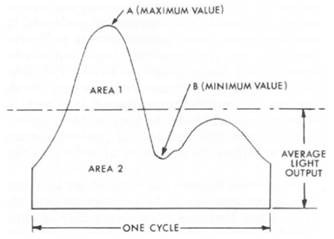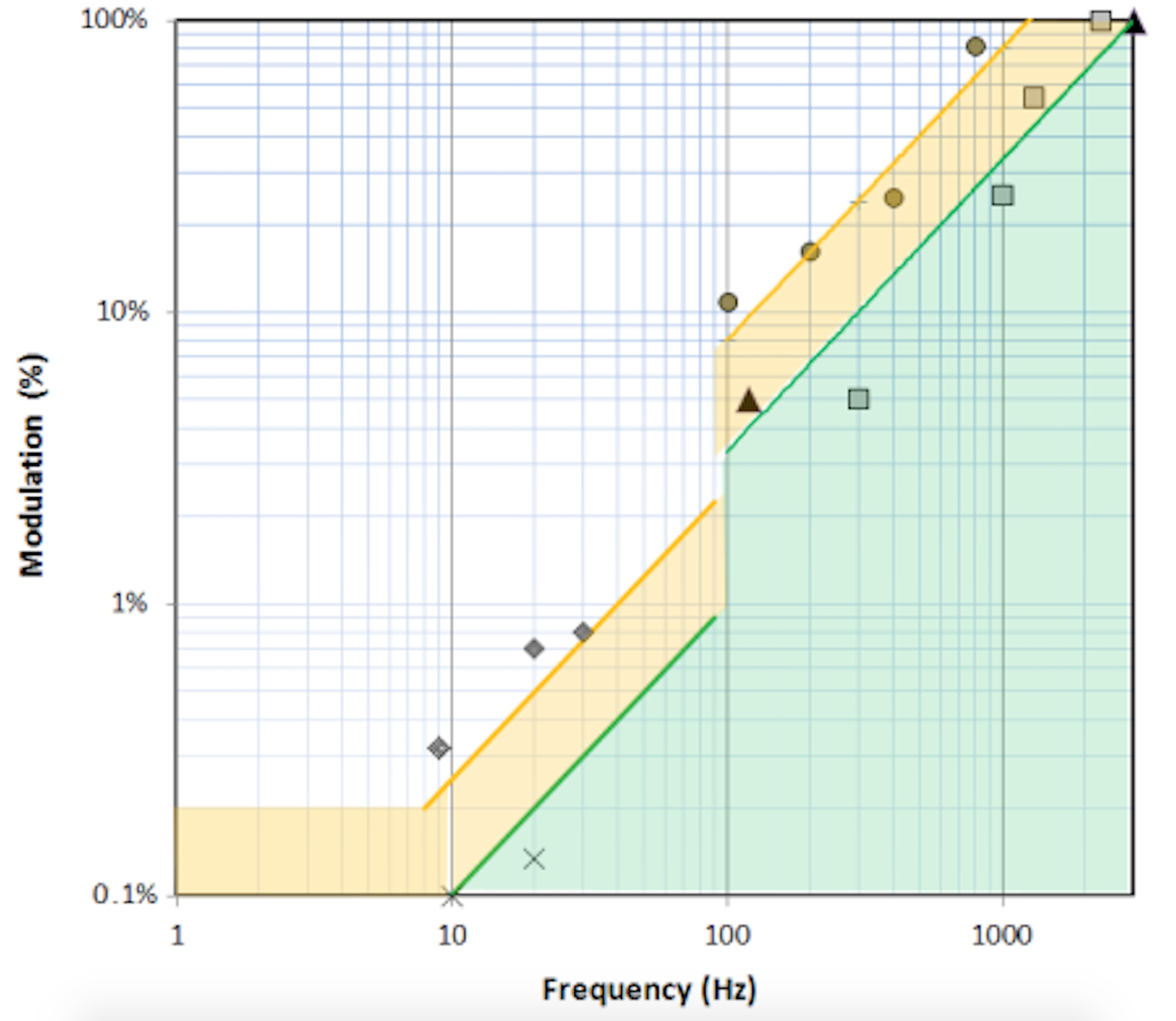LED Lighting: All Eyes on Flicker by Tridonic
Flicker was a familiar problem with early fluorescent lamps. However, increasingly powerful electronic control gear has largely offset these interferences over time, banishing them from current perception. Since LEDs (light-emitting diodes) have become established in all areas of lighting, including general lighting, flicker has reemerged. LED Drivers play a key role in producing light that is as flicker-free as possible.
Energy-efficient LED lighting and increasing demands on the quality of light and lighting comfort are once again focusing attention on flicker and how to avoid it. Flicker can be described as a change in light intensity or brightness over a certain period of time. It occurs in a number of lighting applications, including slow motion shots on TV – in sports broadcasts in particular –, tunnel lighting, various areas of general lighting, and workplaces where fast rotating machinery is used. Depending on the frequency and a person's sensitivity, flicker can affect people's well-being. While high frequencies do not have any measurable effects on well-being, lower ones up to 120 Hz often do. This article focuses on this frequency range up to 120 Hz which most people find annoying.
How is flicker created?
There can be various reasons for flicker. For manufacturers of control gear, ripple current is one which plays a major role. Ripple current is a proportion of alternating current that remains after rectification and the output filters. It is superimposed on the direct current and can have a different frequency and curve. This proportion of alternating current leads to power fluctuations at the LED module which in turn create changes in luminance. The amount of superimposed alternating current and its frequency are deciding factors for the resulting flicker. The carrier technology used in the LED light source and the luminaire design also play a major role. If, for instance, phosphor is used as a converter material in LED light sources, this layer has a capacitive effect and will eliminate a small portion of the superimposed alternating current.
 Figure 1: Flicker is calculated using the amplitude difference and the areas above and below the average value (Graphic: Tridonic)
Figure 1: Flicker is calculated using the amplitude difference and the areas above and below the average value (Graphic: Tridonic)
Individual perception
Depending on a person's sensitivity and type of activity, flicker can be intrusive, distracting and can also affect a person's well-being, even if luminance fluctuations are beyond the perceptible threshold (indirect perception). Here, peripheral vision often plays an important role, as it makes all movement seem more intense – no matter whether it is flicker or moving objects.
The extent to which flicker is perceived also depends on personal perception, and is connected to such things as vision, the irritability of the retina in the human eye, and the lighting conditions at the time. The majority of people are most sensitive at frequencies around 10 Hz, whereas most of the time they are no longer consciously aware of changes above 70 Hz. Nevertheless, people sensitive to light may experience problems such as fatigue and headaches, or there may be irritating stroboscopic effects at higher frequencies.
According to IEEE 1789-2015, there are now detailed descriptions on known flicker phenomena, their frequency of occurrence and their effect in various frequency ranges, and recommendations for driver design. Depending on whether flicker occurs in the perceptible range up to 70 Hz or the imperceptible range, different limit values apply. While as little as 0.5% of flicker can be perceived in the most sensitive range at around 10 Hz, flicker at 60 Hz needs to be at 60% to be perceived, in other words it needs to be 120 times stronger. Therefore, the limit values are considerably higher in this range.
 Figure 2: As routine flicker measurements – in this case via the ripple current – at Tridonic's control gear show, the measured values stay below the relative perception threshold (Graphic Tridonic)
Figure 2: As routine flicker measurements – in this case via the ripple current – at Tridonic's control gear show, the measured values stay below the relative perception threshold (Graphic Tridonic)
High-quality drivers can reduce flicker considerably
Due to rectification of the mains voltage – 50 Hz in Europe – there is a high proportion of ripple current in LED Drivers at twice the mains frequency around 100 Hz. What's more, compared to conventional light sources, LEDs immediately convert the operating current to light without the need for any major smoothing effects. To achieve operation that is as flicker-free as possible, a high-quality LED Driver and compatibility between the driver, dimmer and LED module are crucial. The information in data sheets often provides an approach for rating control gear, for instance under “Output current ripple” or “Superimposed alternating current”. The values indicated usually refer to 100 Hz. The lower the values, the lower the risk of flicker.
Modern high-quality control gear such as Tridonic's LED Drivers minimise ripple at the output and operate with perfectly matched components. High-quality components with clearly defined parameters which are constantly checked in the lab are used. The manufacturer particularly focuses on the critical frequency range around 10 Hz. Tridonic is looking to define new market standards here. Older generation devices with high ripple are now only recommended for applications which do not require persons to be permanently present.
 Figure 3: For the first time, the 1789-2015 IEEE standard provides comprehensive recommendations for reducing the health risk for people. The graph shows limit curves for flicker across the frequency range with low or no visible risk (green area) to people's health (Graphic IEEE)
Figure 3: For the first time, the 1789-2015 IEEE standard provides comprehensive recommendations for reducing the health risk for people. The graph shows limit curves for flicker across the frequency range with low or no visible risk (green area) to people's health (Graphic IEEE)
Recommended dimming methods
While LEDs themselves carry no risk of flicker, dimming them, especially via pulse width modulation, can exacerbate flicker or even cause it in the first place. To avoid flicker, other dimming methods such as analog dimming are preferable. To compensate for the disadvantages of analog dimming at low dimming values, hybrid methods are becoming established.
Conclusion
Data on ripple currents in drivers provide a first indication of the risk of flicker. More reliable information for an informed decision can be obtained from data for the whole luminaire. Luminaire manufacturers can provide detailed information on the control gear used, the amount of superimposed alternating current, the dimming method and the frequency curves. Especially frequency curves between 0 and 120 Hz give an indication of how likely flicker is. The range between 10 and 70 Hz deserves special consideration because in this range flicker has the greatest impact on well-being. What's more, avoiding PWM dimming entirely will ensure largely flicker-free ambient conditions.
Author
Stefano Rosa is Global Channels Director at Tridonic. The Italian-French Electronics Engineer has more than 20 years of experience in the electronics business. In his role as Global Channels Director, he is responsible for defining strategies and tools for sales. His special focus is on growing sales in areas in which a technology migration is taking place. He has profound experience in the electronics, semiconductor and lighting industry and is fluent in five languages.
Figure 4: Stefano Rosa, Global Channels Director at Tridonic
About Tridonic
As a leading international supplier of intelligent and efficient lighting solutions, Tridonic supports its customers and business partners on their journey to greater success with intelligent, impressive and sustainable lighting. Our components and lighting systems offer the highest quality, absolute reliability and considerable energy savings, giving our customers a distinct competitive advantage.
Tridonic constantly brings innovations and state-of-the-art lighting systems to market. More than 95 percent of our R&D projects are devoted to the development of new LED systems and technologies for networked light. Thanks to our expertise and know-how in vertical lighting applications (in retail outlets, offices, educational establishments, outdoor installations and industry, for example), leading luminaire manufacturers, architects, electrical planners, lighting designers, electrical contractors and wholesalers place their trust in Tridonic for their indoor and outdoor lighting.
Tridonic is part of the Zumtobel Group and has its headquarters in Dornbirn, Austria. In the 2014/15 fiscal year, Tridonic achieved sales of 393.8 million euros. 1,750 highly qualified employees and sales partners in 51 countries throughout the world are committed to the development and introduction of new, intelligent and networked lighting systems. With over 40 million light points installed per year, Tridonic is ideally placed to position lighting as a key element and important infrastructure for networking more than just light (the internet of things). www.tridonic.com

